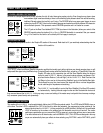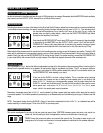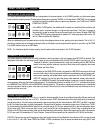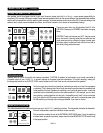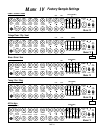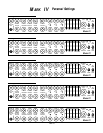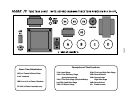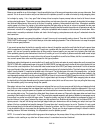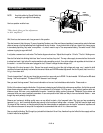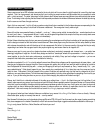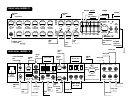
PAGE 18
You may occasionally experience some form of tube noise or microphonics. Certainly no cause for alarm, this quirky behavior comes
with the territory and the Tone. Much like changing a light bulb, you don’t need a technician to cure these types of minor user
serviceable annoyances and in fact, you’ll be amazed at how easy it is to cure tube problems...by simply swapping out a pre-amp or
power tube!
First may we suggest that you set the amplifier up on something so that you can get to the tubes comfortably without having to bend
down. It also helps to have adequate lighting as you will need to see the tube sockets clearly to swap tubes. Use caution and common
sense when touching the tubes after the amplifier has been on as they may be extremely hot! If they are hot and you don’t want to wait
for them to cool off, try grasping them with a rag and also note that the glass down around the bulbous silvery tip is considerably less
hot which makes it easier to handle. Gently rock the tube back and forth as you pull it away from its socket.
There are two main types of tube faults: shorts and noise. Both large and small tubes may fall prey to either of these problems but
diagnosis and remedy is usually simple.
If a fuse blows, the problem is most likely a shorted power tube and shorts can either be mild or severe. In a mildly shorted tube the
electron flow has overcome the control grid and excess current flows to the plate. You will usually hear the amp become distorted and
begin to hum slightly. If this occurs, quickly look at the power tubes as you switch the amp to STANDBY and try to identify one as
glowing red hot. It is likely that two of a pair will be glowing since the “shorted” tube will pull down the bias for its adjacent mates, but
one tube may be glowing hotter — and that one is the culprit. The other two are often fine — unless they’ve been glowing bright red
for several minutes.
Because there is no physical short inside the tube (just electrons rioting out of control) merely switching to STANDBY for a few
moments then back to ON will usually cure the problem...at least temporarily. Watch the tubes carefully now. Should the problem
recur, the intermittent tube will visibly start to over heat before the others and thus it can be identified. It should be replaced with one
from the same color batch, shown on its label. Call us and we will send one out to you. The severe short is not nearly so benign. In
the worst cases, a major arcing short occurs between the plate and the cathode with visible lightning inside the glass and a major
noise through the speaker. If this is seen to happen, IMMEDIATELY turn the amp to STANDBY. By this time the fuse probably will have
blown. Such a short is usually caused by a physical breakdown inside the tube including contaminate coming loose or physical
contact (or near contact) between the elements. Replace it and the fuse with the proper slo-blo type and power up the amp using the
power up procedure as we described earlier in this manual.
Often caused by contamination within in a tube, the culprit can usually be identified, and by lightly tapping on the glass, you will
probably hear the noise change. Hearing some noise through the speakers while tapping on the 12AX7’s is normal however. And the
one nearer the INPUT will always sound louder because its output is being further amplified by the second 12AX7.
The power tubes should be all but quiet when they are tapped. If crackling or hissing changes with the tapping, you have probably
found the problem. To confirm a noisy power tube, merely put the MARK IV on Standby, remove it from its socket and turn it back
on. It will cause no damage to run the MARK IV briefly with one power tube missing. You may notice a slight background hum,
however, as the push-pull becomes unbalanced. Whenever you are trying to diagnose a suspect tube, keep your other hand on the
POWER and STANDBY switches ready to shut them off instantly in the unlikely case you provoke a major short. If you think you’ve
located a problem tube but aren’t sure, we recommend substituting the suspect with a new one just to be sure of your diagnoses. You
will be doing yourself and us a big favor by just following the simple guidelines previously mentioned regarding tube replacement.
You’ll probably be successful with much less effort than is required to disconnect everything and haul the unit to a technician who will
basically perform the same simple tests. If the tubes are still within their six-month warranty period, we will happily send you a
replacement. Just note the color designation on the tube label so that we can send you the appropriate match.
DIAGNOSING POWER TUBE FAILURES:
TUBE NOISE & MICROPHONICS
TUBE NOISE:



